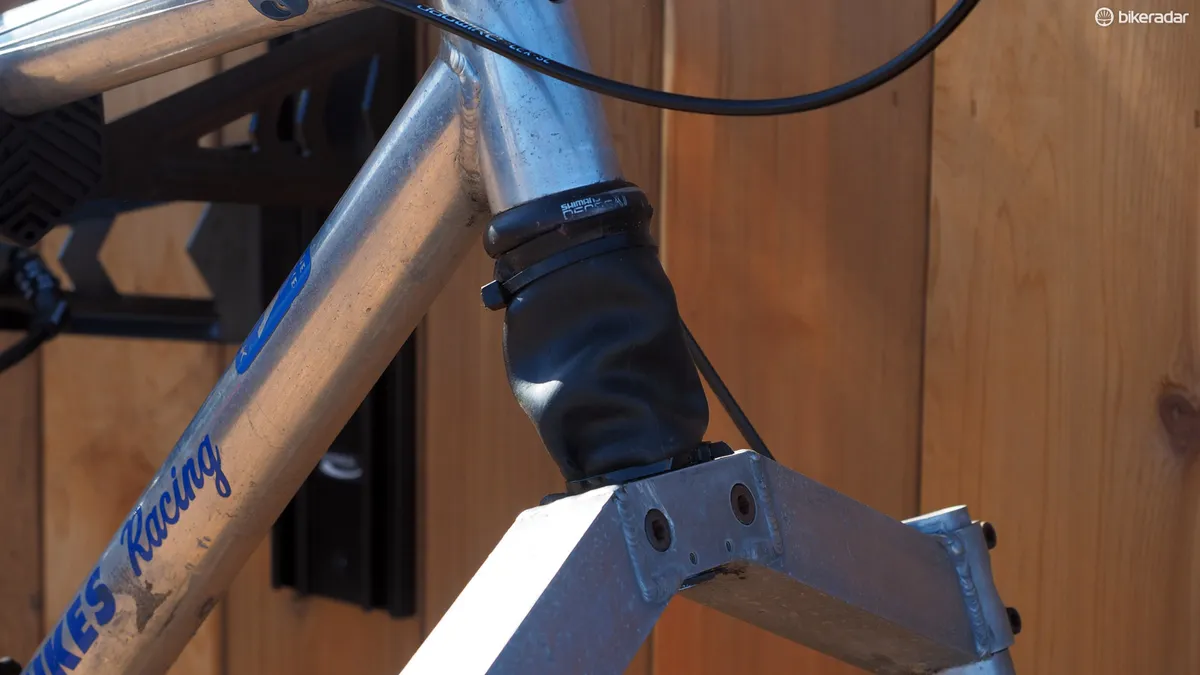Traveling exhibits are commonplace when it comes to the arts and sciences but it’s rare for a bicycle museum to let a substantial portion of its collection roam outside its doors. For this month’s Throwback Thursday, we take a special look at some vintage bikes from Portland, Oregon shop Velo Cult, which graciously loaned out several of its prized machines to a display that Subaru put on at this year’s Sea Otter Classic.
While many see Velo Cult as a bike shop that happens to have a vintage bike collection, the reality is the latter came first and actually allowed the former to exist.

The Skinner Descender sported six inches of rear wheel travel - in 1982!
“I own Velo Cult bike shop but really my shop started as an online business buying, restoring and selling vintage road bikes,” said shop owner Sky Boyer. “This was quite a few years back and while my business was restoring and selling road bikes, my personal passion is classic mountain bikes. Since my job was finding classic bikes, it was a full time objective searching them out and at the time classic mountain bikes were easier to find and not worth nearly what they are today. Not being worth much meant I could buy quite a few and trade up often. Selling off most of that collection is how I funded the build-out of my new store.”
On the surface, the collection certainly is extremely diverse, comprising everything from a Ti Cycles beam bike to a 1950s Hetchins to a late 1970s Victor Vincente Topanga.
“My collection is pretty much reserved for custom made rarest of the rare bikes,” he said. “I have an affinity for mountain bikes that were game changers in the industry so my collection can seem very diverse for that reason.”

The Yeti Ultimate was unquestionably an object of lust in the early 1990s
Subaru’s display at Sea Otter paired several generations of the Japanese company’s cars with bikes of similar vintage. Modern steeds such as from Argonaut and Breadwinner decorated newer models but we were obviously more interested in the older stuff. Booth PR coordinator Billy Sinkford told BikeRadar that of all the bikes he’s had shipped over the years, he was certainly most worried about these. While many bikes are expensive, the ones that Boyer loaned out were simply irreplaceable.
“My favorite would be the Yeti Ultimate for its iconic look and backstory on those frames,” Boyer said. “Second would be the Skinner Descender from 1982. That’s the same year as the first production Stumpjumper yet it has long travel rear suspension and a rigid fork. Both those bikes are indicative of early Los Angeles mountain bikes, which took their style cues from BMX and motocross. Bay Area bikes took their cues from 1930's Schwinn cruiser bikes.”

Carbon is hardly a new phenomenon in mountain bikes. This Trimble dates back to 1993
Perhaps not surprisingly, Boyer doesn’t grant himself the luxury of riding the bikes in his collection. Many are priceless, after all, and the reality is that modern bikes are often simply better suited for the job.
“I have other bikes I prefer to ride and honestly Portland has very few trails; ones we do have are suited to full suspension modern bikes. Maybe someday Portland will see the light and more trails and trails of different types will pop up. Until then I will continue to ride my four regular go-to bikes.”

Moots is best known for its titanium frames now but it started out with steel
Though the Velo Cult museum is quite well stocked already, Boyer admits that it’s always a work in progress with several notable omissions.
“I have owned most every rad bike out there but there are two that have eluded me actually: a Doug Bradbury Manitou and a Cunningham.”
Anyone out there have one they’d like to sell? You can contact Boyer – and take a virtual tour through the museum – at www.velocult.com.






































